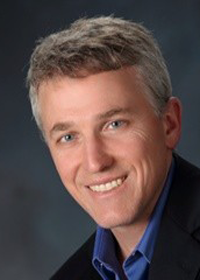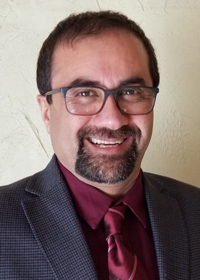Session Organizer: Marc Horner, ANSYS
Computational modeling and simulation is increasingly being used by the medical device industry to accelerate the development of next-generation therapies. But the industry has struggled with developing credible models that can support regultory review. The ASME V&V 40 standard is an FDA-recognized standard that provides a risk-based framework for establishing the credibility requirements of a computational model. Speakers in this session will summarize the application of this standard for a variety of device applications. NOTE: This session is designed to complement the ASME V&V 40 training course which takes place Monday April 17th.
Perspectives on Computational Heart Valve Modeling: Contexts of Use, Risk, Validation, Verification and Uncertainty Quantification

Tinen Iles
Assistant Professor in the Department of Surgery at the University of Minnesota Medical School
Abstract: This talk will provide an introduction to Verification and Validation (V&V) as it relates specifically to the simulation of heart valves and outlines the importance and nuances from an engineering perspective. The discussion focuses on an industrial V&V process for structural modelling of an implantable device, presented as an end-to-end example. This example demonstrates the application of the ASME V&V 40 standard to the credibility assessment of a transcatheter aortic valve (TAV) FEA model, used in Design Verification (21CFR 820.30(f)) activities. In particular, the FEA model is utilized for structural component stress/strain (metal fatigue) analysis, in accordance with practices outlined in ISO5840-1:2021. The rapid expansion of modeling and simulation across the heart valve life cycle has necessitated codification of a risk-based framework for model VVUQ (Verification, Validation, Uncertainty Quantification). ASME VV40, recognized by the FDA, provides this framework. The framework is flexible in its implementation and can be applied to models spanning a wide range of Contexts of Use and risk levels. It is ultimately up to the end user to ensure that model credibility is commensurate with the risk associated with the model.
Bio: Dr. Tinen L Iles is an Assistant Professor in the Department of Surgery at the University of Minnesota Medical School. Prior to receiving her professorship, she was a scientist in the Department of Surgery focusing on cardiac research and device design. Before academia, she worked in industry focusing on neuroscience and pharmacology and continues to have interests in industrial-academic collaborations. Dr. Iles received her PhD from the University of Minnesota in Bioinformatics and Computational Biology in 2017 and is on the Graduate faculty for Biomedical Engineering, Bioinformatics and Computational Biology; she teaches and lectures on topics ranging from cardiac anatomy and physiology. device design to applied biophotonics. The goal of Dr. Iles research laboratory is to study how devices, mathematical frameworks, and machines interface with human biology/physiology and the clinical impact of what we learn from this research by developing unique methods for translational research with a multidisciplinary approach.
Enhancing Model Credibility Using Clinical Data – Applications in Shoulder Arthroplasty

Jeffrey Bischoff
Sr Director, Research, Zimmer Biomet
Abstract: Use of benchtop data to demonstrate the credibility of computational models of medical device performance is a well-established approach for model validation. A framework for evaluating the credibility of such activities was published by ASME in 2018, and has been heavily used in the medical device industry. More recently, the US FDA issued a draft guidance on model credibility, in which the use of clinical data is considered. There are few contemporary examples, however, where the use of clinical data for enhancing the credibility of a computational model intended to support medical device development has been demonstrated. Here, several case studies related to total shoulder arthroplasty are presented, in which traditional benchtop validation activities are supplemented with clinical validation activities so as to ensure the modeling approach is both technically accurate and clinically relevant.
Bio: Dr. Jeffrey Bischoff is the Director of Biomechanics at Zimmer Biomet, where he has been since 2006. Prior to joining the medical device industry, he completed his Ph.D. in Mechanical Engineering at the University of Michigan, served as Assistant Professor at the University of South Carolina. Over the past ten years, Jeff has supported device development efforts using computational analysis across a wide range of orthopaedic applications, and throughout the total product life cycle from design ideation through regulatory clearance and commercialization. He has been actively involved with the ASME V&V40 Sub-Committee, including as chair of the orthopaedic working group and as vice-chair of the sub-committee. He recently was appointed to chair of the sub-committee, effective 2019-2022.
CM&S in Clinical Decision Making, Determining Safe Scanning Parameters for patients with Metallic Passive Implant

Payman Afshari, Ph.D
Sr. Principal Engineer DePuy Synthes, Johnson and Johnson
Abstract: Computational modeling and simulation have proven to be an alternative to ex vivo testing in determining the conditional labeling of RF heating parameters of MRI scanners, particularly in regulatory evidence generation, where their impact has been significant. The sea-change has allowed predictive models to explore risks that are not otherwise possible. In this presentation, the role of V&V process for such models and the subsequent downstream impact of CM&S adoption will be discussed.
Bio: Dr. Payman Afshari is a Sr. principal engineer at the DePuy Synthes, Johnson and Johnson. He has more than 15 years of experience in applying computaitonal modeling asimulaiton (M&S) to address challenging problems in design and manufacturig of spinal implans. For the past 10 years, he has been involved in promoing the use of M&S across product life cycle including regualtory evidence generation. Currently, he is vice-chair of ASME V&V40 subcommttee, an active member of ASTM, the Avicenna Alliance, A European predictive medicine organizaiton, Medical Device Innovation Consortium (MDIC) and InSilcioUK initiative. He has co-authored several publicaiton in the area of verification, validation and uncertainty quantification of models in medical device development and regualtory applicaitons.
Diverging Effects of Friction and Contact Stiffness on Global and Local Mechanical Response of Lumbar Interbody Fusion Device Computational Models

Snehal Shetye
Staff Fellow, Mechanical Engineer
U.S. Food and Drug Administration
Abstract: Over 100,000 lumbar interbody fusion surgical procedures are performed in the U.S. per year. Concomitantly, this has spurred medical device innovation with new devices generally seeking clearance under the 510(k) pathway with the FDA. Traditionally, mechanical equivalence is demonstrated by performing side-by-side bench testing with the predicate device. However, this approach can be burdensome due to associated cost of bench testing and difficulty in acquiring competitor devices. To ease this burden, bench testing is often supplemented with computational modeling. Organizations including ASTM and ASME have published standards that utilize finite element modeling (for e.g., F2996) and outline the necessary verification and validation steps to establish credibility (for e.g., V&V40). Finite element analysis (FEA) tools include a multitude of options that when improperly implemented without validation can generate erroneous results. The objective of this study was to investigate the effect of modulating contact friction and contact stiffness on the global force-displacement and local surface strain of a generic L-IBFD family of devices under compressive loading per ASTM F2077. Generic L-IBFD devices with three levels of strength (low, medium, high) were designed. The three designs (n=1 of each strength) were manufactured from medical grade PEEK (Invibio Biomaterials, West Conshohocken, PA) and were tested under quasi-static conditions according to ASTM F2077 (Figure 1A) for calibration and validation of finite element (FE) models. Initial runs on the three device designs demonstrated that the low strength device did not satisfy validation thresholds for the global force-displacement or local strain response. Thus, the low strength model was calibrated by modulating contact stiffness factor from 0.1 to 10 and modulating contact friction from 0.1 to 0.5 to improve FE predictions when compared to bench testing. Tuning contact friction and stiffness on the low strength device revealed that higher values of contact stiffness and contact friction resulted in increased fidelity of the global force-displacement model prediction. However, this phenomenon was reversed for surface strain measurements with lower values of contact friction and stiffness providing higher model fidelity of local surface strain predictions. This phenomenon highlights the need to a priori establish calibration practices, validation criteria for the model, and associated acceptable model risk.
Bio: Dr. Snehal Shetye is a Staff Fellow in the Division of Applied Mechanics within OSEL. Dr. Shetye received his doctorate in Mechanical Engineering from Colorado State University. He then completed post-doctoral fellowships at the University of Pittsburgh and another post-doctoral fellowship at Colorado State University. He then worked as a Senior Research Investigator for 6 years in the Department of Orthopaedic Surgery at the University of Pennsylvania with Dr. Louis Soslowsky and Dr. Robert Mauck before joining the FDA in August 2021. Dr. Shetye’s expertise is in developing novel mechanical testing methods for a variety of joints and soft tissues using animal models or cadavers. He has complemented his biomechanical expertise by creating complex finite element computational models of the wrist, knee, and cervical spine.
Session Organizer Bio

Marc Horner
Distinguished Engineer, Ansys
Dr. Marc Horner is a Distinguished Engineer leading technical initiatives for the healthcare industry at Ansys. Marc holds a number of industry leadership positions, with a focus on model credibility frameworks, regulatory science, and clinical applications. These include Vice Chair of the ASME V&V-40 Sub-Committee and Avicenna Alliance Global Harmonization Task Force Leader.